2020 Jeep Gladiator First Drive: Pickup Artist
Building a pickup with personality is tougher than it sounds, and so the 2020 Jeep Gladiator was always going to be divisive. Brash, unapologetic, and digging enthusiastically into a lengthy history of Jeep 4x4 heritage and iconic styling, the Gladiator could be at best a new truck hero, or at worst an overdue pastiche. Buckle up, because things get bumpy.
The 2020 Gladiator looks good. Really good
Some drives you go into with a little bias on your sleeve. I'm not your typical truck buyer, but I do think the Gladiator looks fantastic. No, I don't really need a pickup, but I wasn't averse to being so swayed by deep Jeep joy that a trifling detail like that could be overlooked.
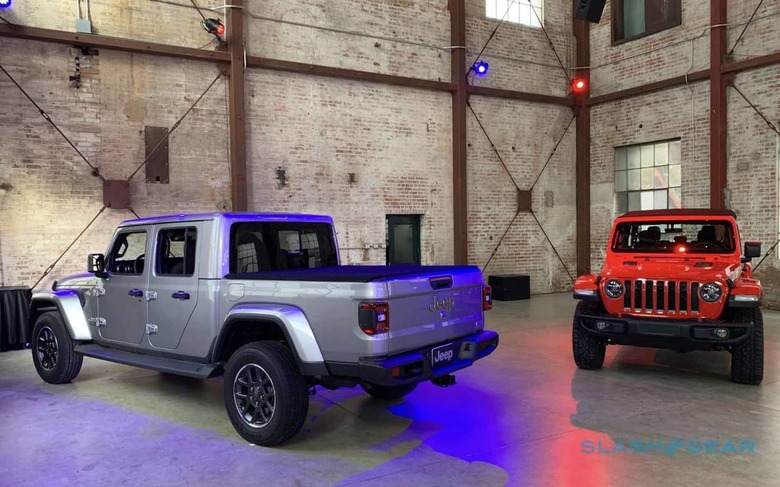
It's no less chunky and charming in the metal. The Gladiator is like a kid's toy truck come to life, instantly recognizable with its keystone grille and circular headlights. There'll be an entry-level Sport, better-equipped Sport S, more luxurious Overland, and finally an off-road-centric Rubicon, all with different combinations of body-color or black cladding, tweaks to the bumpers and fenders, and other trim details.
All, though, are convertibles. Jeep offers a choice of three interchangeable roofs: a soft top, which peels back like the top of a stroller; a black three-piece hardtop; and a body-color three-piece hardtop. Removable panels in the Freedom Top model expose the front seats to the sky.
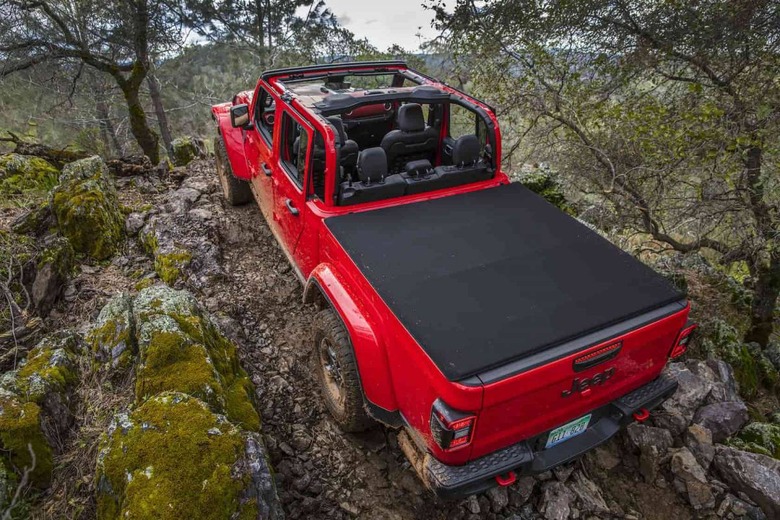
Like the Wrangler, though, you can go even further. Whip out the Torx bolts and you can remove the Gladiator's doors; do the same for the windshield, and that can fold down flat. You'll need goggles if you want to avoid an eyeful of bugs and road grit, mind.
Jeep does everything it can to encourage you to do it, too. The necessary tools come as standard, and there's a handy box – complete with molded legends showing which bolts go with which part of the car – to safely store the fastenings after you've removed them.
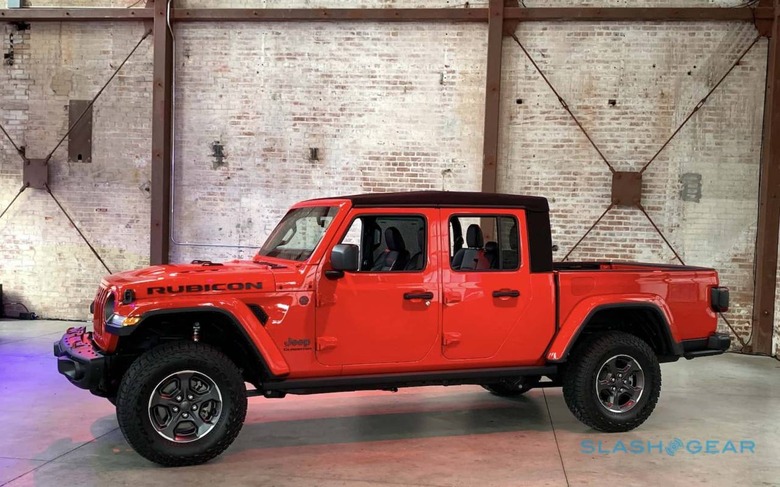
It's not the only clever detail. There's a long, shallow storage space under the rear bench – which lifts, single-handed, with a 60/40 split – and an optional removable, locking bin with adjustable dividers that can slot there. A little more storage is found behind the seat backs, along with a removable, rechargeable, and waterproof Bluetooth speaker; the seats lock upright so that, even if you've taken the doors off, there's still somewhere safe to leave your bag or purse.
No mere Wrangler with a box
The familiar design might lead you to assume Jeep took the easy option: bolt a box onto the back of the Wrangler and call it a day. Even Jeep itself concedes that would have been the simplest route – and the fastest. The automaker could've used the previous-generation Wrangler "JK" platform for a pickup version years ago.
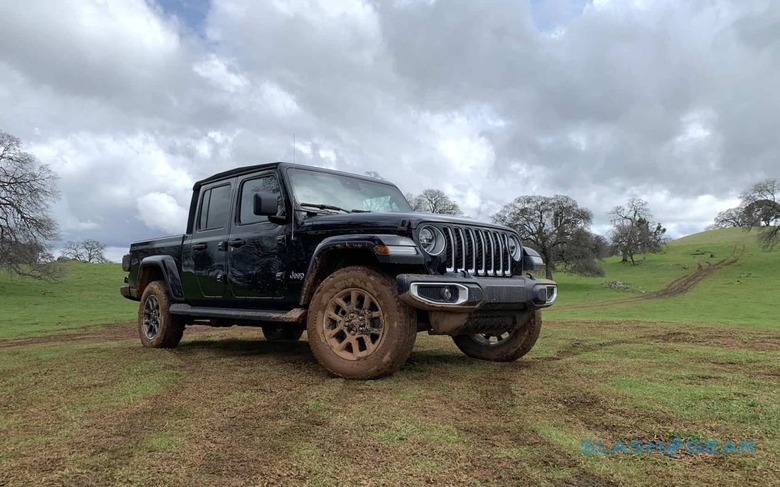
It would've looked the part, Jeep says, but it wouldn't have performed like a proper Jeep pickup should. Instead, a new platform was paired with a classic name from the automaker's vault, and so the 2020 Gladiator was born.
The body-on-frame uses high-strength steel, and is 41-inches longer than the Wrangler 4-door's platform. More than 19-inches of that extra length goes into the wheelbase. It's tougher than the Wrangler frame, too, given that the loads it'll be expected to carry are heavier.
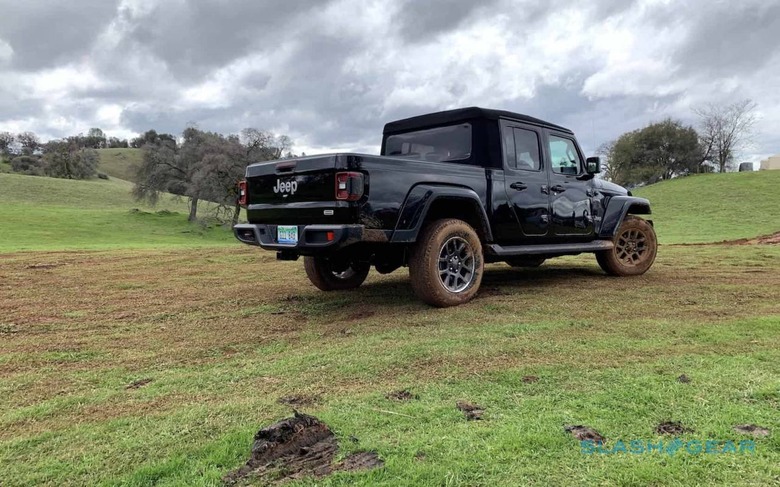
At the back, the 5 foot box is a compromise around practicality, aesthetics, and performance. Jeep intentionally kept the sides relatively low in comparison to other recent pickups, sacrificing bigger volume numbers in favor of a bed you could reach into from the sides. It's spacious enough to hold a claimed 95-percent of motorcycles on the market, while being rated for up to 1,600 pounds of payload. Model-depending, the Gladiator will tow up to 7,650 pounds.
The box itself is steel, with four steel cross-members. However the tailgate – like the fenders, hood, windshield, and doors – is aluminum, to keep the weight down. Even so, the Gladiator tips the scales by as much as 5,000 pounds: 500 pounds or so more than the comparable Wrangler 4-door.
On the road, a Wrangler-like ride
The weight, and that body-on-frame platform, add up to a fairly predictable driving feel when you're on the road. Like the Wrangler, it can be a bouncy affair. That lends itself well to sensible cruising, but counts the Gladiator out of more eager driving. Coupled to the heavily-assisted electro-hydraulic power steering, which has a lot of play, and you end up feeling disconnected from the road.
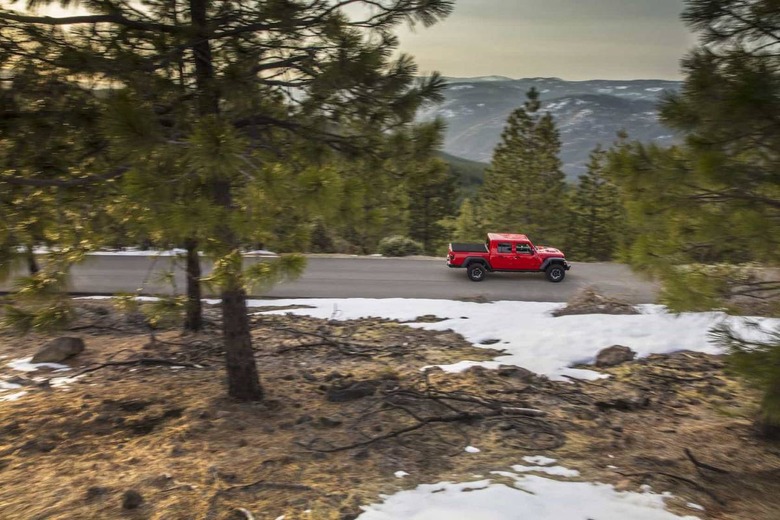
It's a shame, as there's no shortage of power. The 3.6-liter Pentastar V6 offers 285 horsepower and 260 lb-ft of torque, and it's more than sufficient to get the Gladiator going. I'd have liked to have seen the Wrangler's four-cylinder hybrid offered, but right now there's just the one engine to choose from. A diesel, with 260 horsepower and 442 lb-ft of torque, is in the pipeline for 2020.
As for economy, that depends on which transmission you go for. I spent most of my time in the optional eight-speed automatic, and never found myself questioning its choice of gear. There, the EPA rating clocks in at 17 mpg in the city, 22 mpg on the highway, for 22 mpg combined.
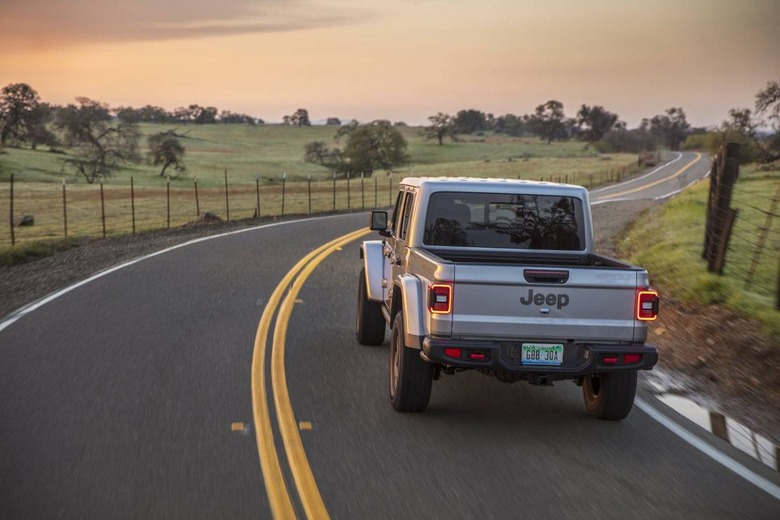
The standard six-speed manual, meanwhile, delivers 16 mpg in the city, and 23 mpg on the highway. That still works out to 19 mpg combined, and it saves you the $2k of the automatic.
Mud and rocks and now it all makes sense
It only took a minute or so away from asphalt to realize where this pickup really shines. Faced with mud, rocks, and puddles of indeterminate depth, the truck's softer suspension and lighter steering-feel immediately proved their worth.
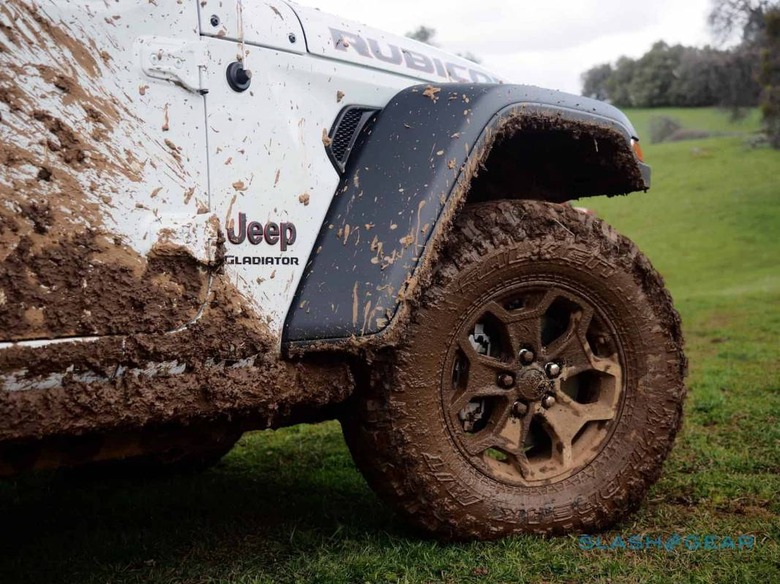
Every Gladiator is 4x4 as standard, as you'd expect, but Jeep has two different configurations. The Sport, Sport S, and Overland have a Command-Trac transfer case, open front and rear differentials, and an optional Trac-Lok anti-spin rear diff. The Rubicon, meanwhile, gets a Rock-Trac transfer case with a better low range ratio, and Tru-Lok electronic locking differentials front and rear as standard.
Either way, there's a lever to shift between 2WD High, 4WD High, Neutral, and 4WD Low. The Rubicon adds a separate control panel, with which you can lock either the Front + Rear or just the Front diff, disconnect the sway bar, or turn on Off Road+ mode. The latter automatically adjusts the settings depending on whether you're on high- or low-friction surfaces like rocks or sand.
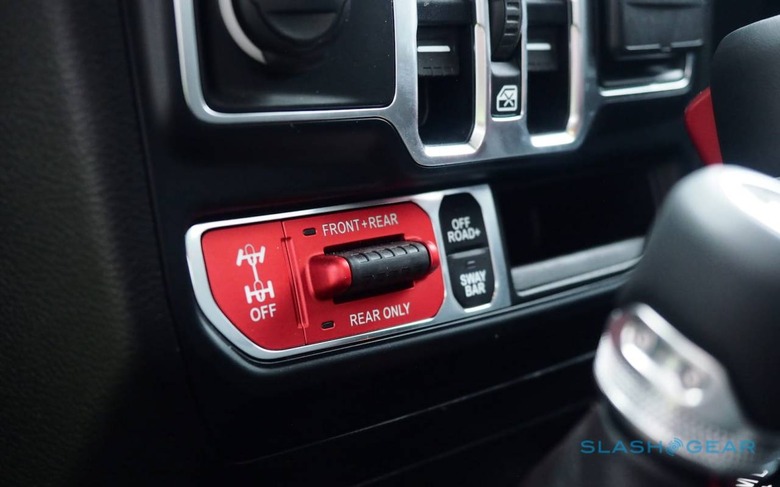
Automaker off-road courses typically aren't all that challenging. After all, it's in their best interests to show their truck clambering serenely over just-tricky-enough terrain, perhaps kicking up a back wheel for some suitably dramatic photos. Clearly everybody at Jeep had missed that memo.
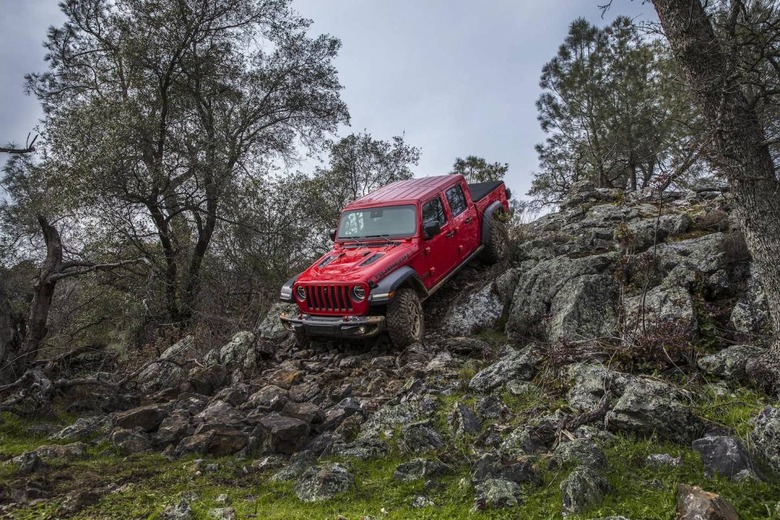
As the lead Wrangler peeled off to the side, I found myself facing what resembled the aftermath of a rock fall, or maybe an earthquake-shattered Stonehenge. An unruly tumble of jagged stones, huge and uninviting, and with just enough mud left by earlier drivers to leave the glistening pile looking treacherously slippery. I'd expected chunky gravel; this was post-apocalyptic collapsed parking structure.
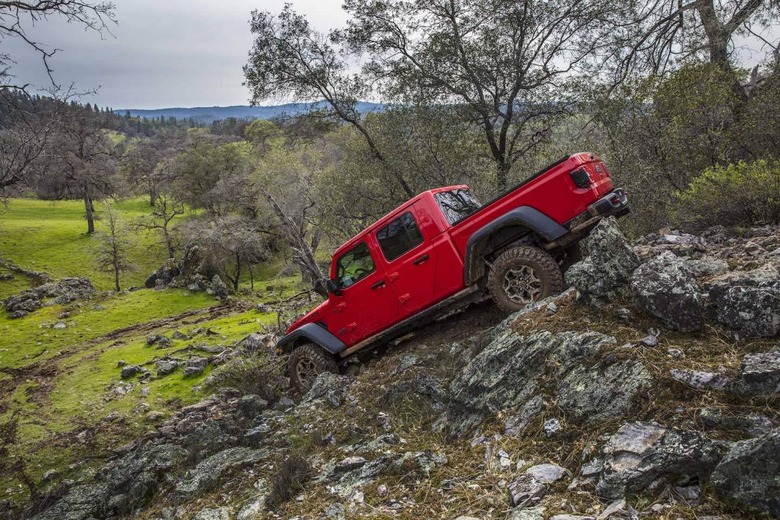
Gladiator in 4WD Low, the diffs locked and my nerves steeled, I pushed forward. The Rubicon's optional front camera – complete with an entertaining little cleaning jet designed to wash dirt off the lens, and dynamic grid lines that move according to the angle of the wheels – suddenly stopped feeling like a gimmick and started making a lot more sense. With it, the two feet right ahead of the truck was instantly visible, useful given I could see nothing but sky over the hood. The only thing that would make it better would be a dedicated shortcut button; as it is, you have to dig into Uconnect to access it.
Tipping down over the opposite side, the rocks suddenly angled steeply. The Rubicon gets 17-inch wheels with 33-inch Falken Wildpeak LT285/70R17C rubber as standard, with either all-terrain or mud-terrain tread. I could feel them fighting gravity as the Gladiator leaned precariously to the right. "Slower!" bellowed Jeep's spotter. My foot, already burying the brake to the wash-out floor, tried in vain to press even harder; any remaining movement was down to the unstable surface shifting beneath us. My co-driver may have squeaked with alarm.
By the point where we were level again, it was time to tackle the next obstacle. More haphazardly strewn rocks; more disconcerting angles; and more ruts and furrows. The Gladiator has 11.1-inches of clearance and can wade into water up to 30-inches deep. That, and the tenacious grip from the tires meant even the unctuous mud couldn't hold me back.
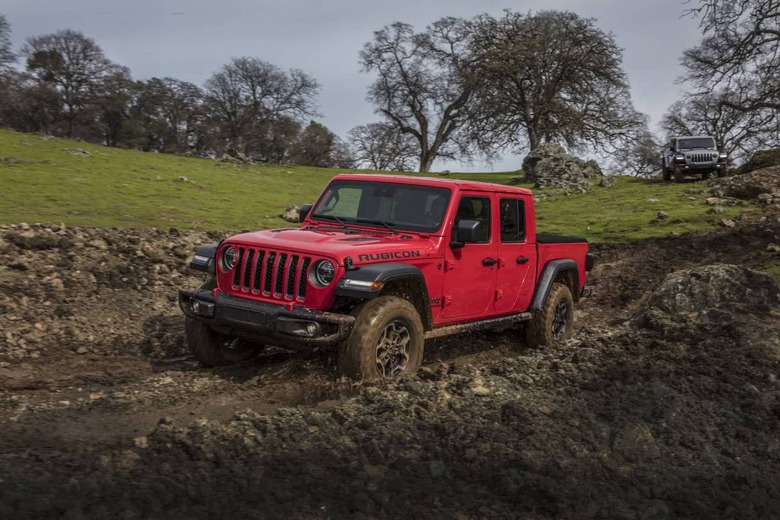
The Gladiator's only real shortcomings came in comparison to the Wrangler Rubicon ahead of us. The pickup has a 43.6-degree approach angle, 20.3-degree breakover angle, and a 26-degree departure angle in its Rubicon form, and it was the last two figures – the departure angle a full 11-degrees less than the 4-door Wrangler – which led to some of the more ominous grinding sounds as the rear scraped its way free. Happily Jeep slaps on plenty of underbody and rail protection.
Practicality is king
The $33,545 Gladiator Sport isn't as spartan as the mid-$20s Ford Ranger or Toyota Tacoma, but it's the $36,745 Sport S where things start to get interesting. At that point you have power locking and power windows, tinted glass, power heated mirrors, dual-zone HVAC, and keyless entry. Overland and Rubicon trims get LED headlamps and fog lamps, with halo-like daytime running lights. LED rear lights – with integrated cross track detection sensors – are available.
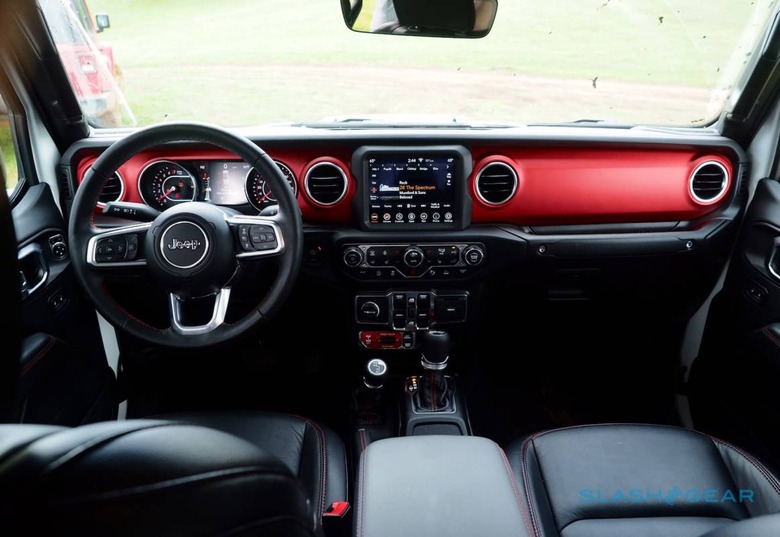
The $40,395 Gladiator Overland and $43,545 Rubicon have the option of leather-trimmed seats instead of cloth. There's the option of a 115V AC outlet in the back, too, as well as up to five USB and USB-C ports spread around the cabin. Soft-grip grab handles on the pillars and ahead of the front passenger were well-utilized on the off-road course.
Sport trim gets a tiny 5-inch touchscreen for Uconnect; the other trims have a much more spacious 7-inch touchscreen, with an 8.4-inch panel and navigation an available upgrade. Eight speakers are standard; a nine speaker Alpine system, with subwoofer, and 552W of power is optional. Uconnect can look a little busy at first glance, but it's fast and fairly sensibly laid-out. There's both Android Auto and Apple CarPlay support.
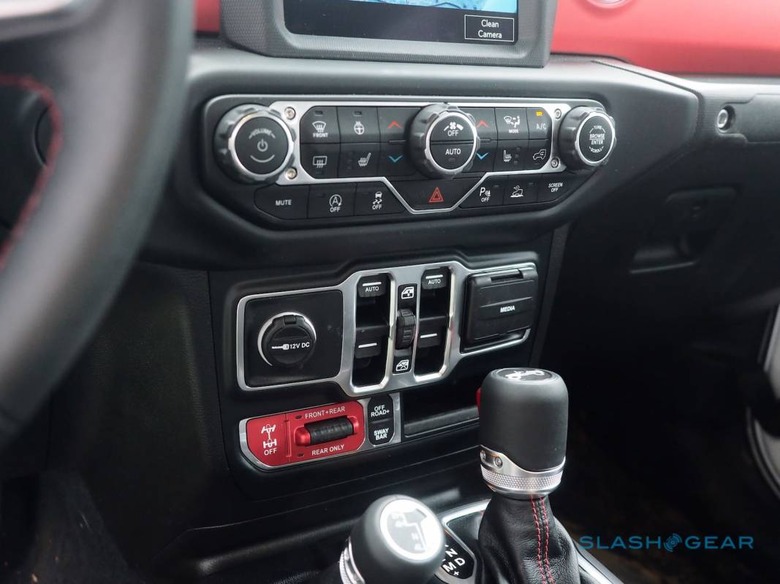
Happily, Jeep also includes plenty of physical controls. The HVAC system gets dedicated buttons and dials – all chunky enough to be used even if you're wearing gloves – while underneath are the power window buttons. It takes some getting used to their placement, but that's the price you pay for having removable doors.
It all looks good. Just on the charming side of quirky, in fact. Second row legroom is a little tighter than in a 4-door Wrangler, but still adult-sized.
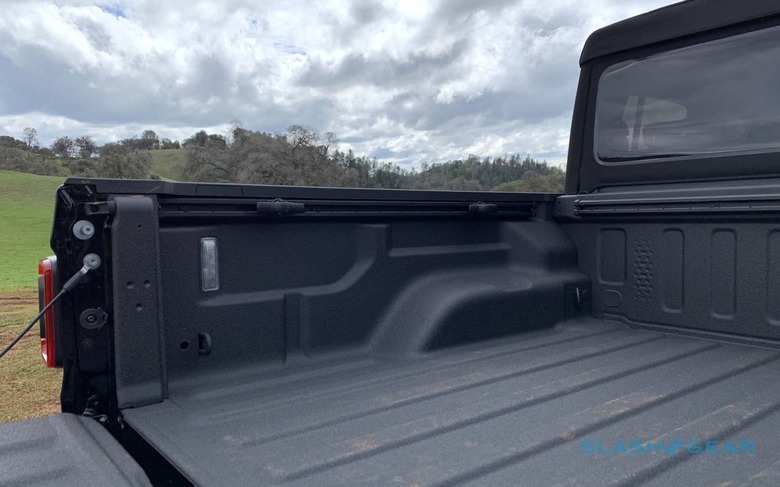
In the box, there are four D-rings, optional LED lighting, and an optional 400W, 115V three-prong outlet. Jeep has an optional bed divider and a tonneau cover; the latter furls back into a tight roll at the base of the rear window, to avoid taking up cargo space. The tailgate can be stopped in three positions; if you've always wanted to transfer up to nineteen 4x8 sheets of plywood, the Gladiator has you covered.
As for safety, Jeep has two packages. The Active Safety Group adds rear parking assistance and blind-spot monitoring. The Advanced Safety Group, meanwhile, includes adaptive cruise control and forward collision warnings. However there's no lane-keeping assistance, no auto-braking for potential collisions, and no 360-degree camera.
2020 Jeep Gladiator verdict
You can't accuse the Gladiator of not delivering on its promise to be "the Jeep of pickups." It looks the part, is as capable off-road as you'd expect it to be, and blends outright practicality with distinctive – and at times playful – features that leave the Tacoma, Ranger, and other rivals feeling positively dull in comparison. Throw in the cavalcade of Mopar accessories, and you've also got a truck with huge customization potential. Just what the Jeep faithful had been hoping for, in fact.
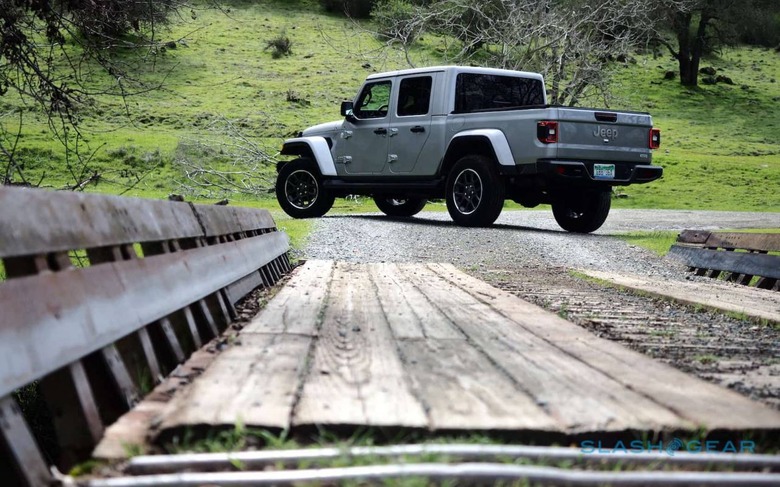
If there's a frustration, it's that the Gladiator's focus on off-road ability has a clear impact on on-road performance. A button which firmed up the steering and tweaked the damping would make a world of difference. Yes, Jeep made a great pickup, but new potential buyers – lured from their SUVs and crossovers by the attention-grabbing design – could well be turned off by how the Gladiator feels from behind the wheel.
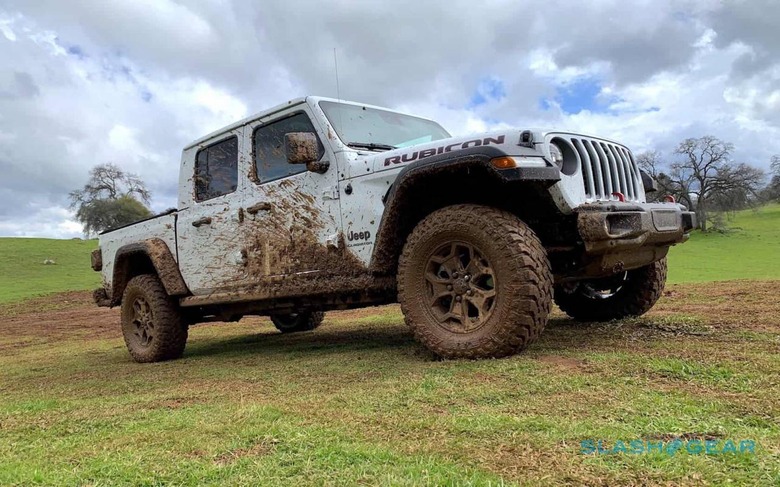
I can't argue that the 2020 Gladiator doesn't achieve what it set out to do. Nor that it will probably sell in bucketloads to Jeep fans. As an outsider to that clique, though, I'm a little sore that Jeep didn't take the chance to make a vehicle which straddled truck heritage and a more general desire among drivers for something with character, but which doesn't feel like a utility. Perhaps in doing so it would've undermined the pickup's whole identity in the process. What I do know is that it's easy to like the Gladiator, but it's only when you take it off-road that you really come to love it.
